How to properly grow green onions on a windowsill: a step-by-step guide for beginners
Residents of city apartments who are not lucky enough to have their own plot of land are forced to buy fresh vegetables and fruits. However, it is quite possible to grow greens even in your apartment. All you need for this is a window sill.
The simplest plant from the point of view of agricultural technology is considered to be onion. It is possible to obtain a harvest of this crop with minimal time and financial costs. By knowing a few rules, you will have plenty of greenery all year round. How to properly grow green onions on a windowsill to get a harvest no worse than from the garden, read on.
Features of growing onions on a windowsill
Any schoolchild knows that onions can be grown on a windowsill without much effort. Even if you stick an onion into the ground without preparation, most likely you will be able to get a green feather from it.
However if grown incorrectly, greens take a long time to germinate, and their quality and yield leave much to be desired. Many have noticed that if there are mistakes in cultivating this plant, green onions turn out to be bitter, dry, tasteless and unflavoured.
Growing juicy and aromatic greens, moderately spicy and sweet, is possible only if you follow the rules of care.

Onions are grown in two ways. The first is planting the bulb. In this case, the harvest appears faster and is abundant. Feathers grown from bulbs are more juicy.
In the second case, seeds are sown on greens. They take longer to germinate, and each seed yields less greenery. It has a richer taste, but is not as juicy.
Note! You can plant onions on your greens at home at any time of the year.
Suitable varieties
To grow green onions on a windowsill, just select a few suitable onions. When planting a large quantity, it is more profitable to buy seeds or special small onion sets.
What varieties It is best to plant greens at home:
- Batun. There are perennial and annual varieties. It is characterized by high yield with medium bush density.
- shallot. Onions with a sweetish aftertaste. It is distinguished by the juiciness and density of feathers. An unpretentious option for experienced and novice housewives.
- Leek. It has large long feathers of dark green color, which in appearance resemble garlic arrows. The taste is sweet and spicy. The aroma is rich.
- Schnitt. It has thin long feathers and high yield. Suitable for growing at home, demanding care.
Onion grown from seeds and sevka. The most popular varieties for home cultivation: Arzamassky, Danilovsky, Yantarny, Bessonovsky, Soyuz, Pozharsky, Rostovsky.
Preparation for cultivation
Contrary to the opinion of many housewives, planting onions requires preliminary preparation. This will accelerate feather growth, strengthen disease resistance, increase yield and improve the taste of greens.
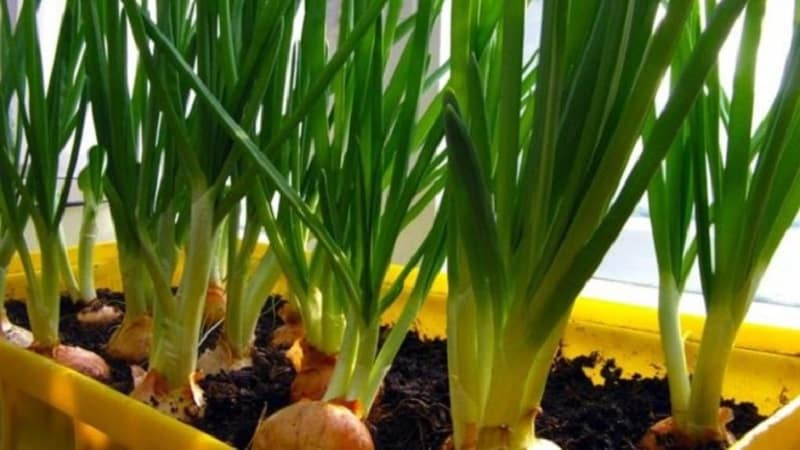
Selecting a location
In the apartment, onions for greens are grown on the windowsill or loggia. The plant needs a lot of light, but it does not like too high temperatures.
In winter, onions are placed on the south, southeast or southwest side. In summer, it is better to choose the northern, southeastern or southwestern part of the apartment.This way the plantings will receive enough light, but will not overheat.
Advice. It is not necessary to place containers with onions on the windowsill. Many housewives build special stands that are placed near the window.
Containers and soil
The soil for onions should be light and nutritious.. A universal mixture for seedlings is ideal. They prepare the soil on their own. To do this, mix in a 1:1:1 ratio:
- garden soil;
- humus, peat or humus;
- sand.
Purchased and homemade soil mixtures require preventive treatment. To do this, the soil is scalded with boiling water, calcined in the oven or microwave, and watered with a dark pink solution of potassium permanganate.
Onions are grown in different containers. The most popular options:
- Egg trays. 1 medium-sized onion is planted in each cell.
- Trimmed 1.5-2 l bottle. This container will fit 3-4 onions.
- Boxes. Typically used for sowing seed greens.
- Plastic cups. Plant 1 onion in each container.
- Plastic pots.
- Plastic bags are the cheapest option.
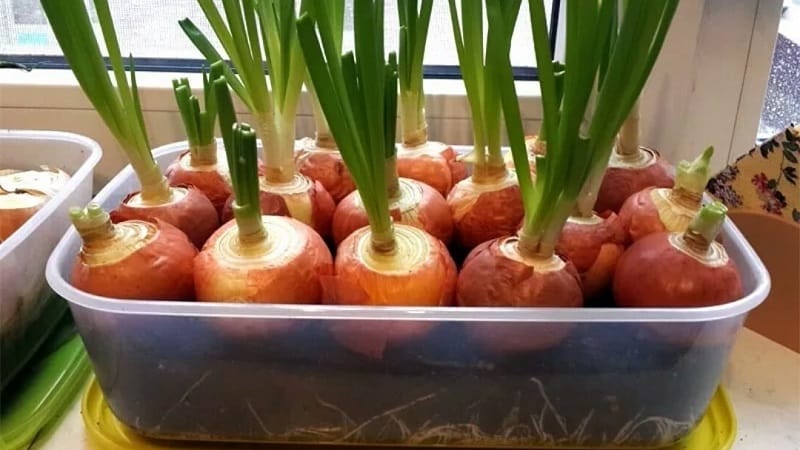
The containers are disinfected: soak for half an hour in a dark pink solution of potassium permanganate or pour over boiling water, if the material allows.
Reference. Peat pots are not suitable for growing greenery on the window. Their use in this case is unprofitable and useless.
Planting material
Planting material needs preventive treatment. It is usually disinfected and growth is stimulated.
Preparing the bulbs:
- Selection of the best planting material. The bulbs should be hard, with a shiny husk, without cracks, damage, or signs of disease on the root base.
- Selected bulbs are kept warm for a week.
- Large bulbs are cut in a wide area.This is not done if the greens have already hatched. Onion sets are not trimmed.
- The bulbs are soaked in a light pink solution of potassium permanganate for 20-30 minutes, and then wiped with a dry cloth.
Some housewives additionally soak the bulbs in water at room temperature for 1-2 hours. A growth stimulator can be added to the water. Folk remedies that accelerate the appearance of greenery are honey and aloe juice.
Preparing onion seeds for sowing:
- Selection of viable specimens. Planting material is poured with a solution prepared from 1 teaspoon of salt and 1 glass of water at room temperature. After half an hour, the floating seeds are removed, and those that have sunk to the bottom are used for planting.
- Disinfection. The seeds are soaked in a light pink solution of potassium permanganate, hydrogen peroxide or Fitosporin for 15-20 minutes.
- Growth stimulation. The seeds are soaked in aloe juice (diluted in half with water), soda solution (1 teaspoon added to 1 glass of water), honey water (1 teaspoon honey per 1 glass of water).
- Many housewives prefer to germinate seeds in advance. To do this, several layers of fabric are laid in a deep container, prepared seeds are laid out on it, and they are covered with several more layers of fabric on top. The material is moistened with water at room temperature. In this form, the seeds are left in a warm place until they hatch. Typically germination occurs within 2-3 days.
Agricultural technology of green onions on the windowsill
Growing onions is not a difficult task. However to get a rich harvest, you will have to take several subtleties into account. This is especially true for compliance with the rules of watering, lighting and temperature indicators.
Landing
Planting whole bulbs and seeds varies. First, let's take a step-by-step look at sowing seeds:
- Fill the selected container with soil so that a few centimeters remain to the edge. A layer of drainage (coarse sand, crushed stone, broken ceramics) is poured onto the bottom.
- The soil is moistened with warm, but not hot water.
- The seeds are laid out at a distance of 0.5 cm from each other, sprinkled with a 0.5 cm layer of sand or earth. Cover with film if the seeds have not been germinated before.
Planting bulbs:
- Horizontal containers are filled with soil so that 5 cm is left free to the edge. A layer of drainage is poured onto the bottom.
- The soil is watered with warm water.
- The bulbs are stuck into the ground with the root bottom and deepened so that they gain stability. In this case, frequent planting is appropriate.
Do not cover the onion with film or other material.
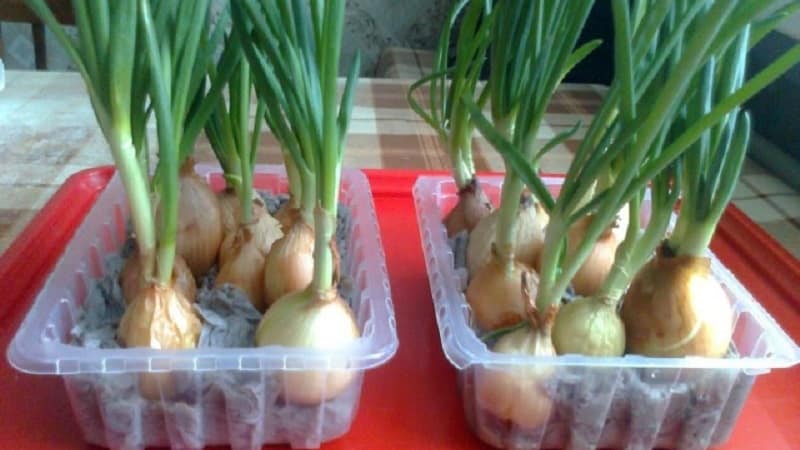
Creating favorable conditions
Despite the fact that onions are an unpretentious plant, its taste and growth rate depend on growing conditions. This is especially true for light and temperature.
Onions are a cold-resistant plant. It is able to grow at temperatures from +10°C. At temperatures from +10°C to +15°C, onion growth slows down, and the harvest will be ready for harvest in a month and a half. To quickly get a lot of greens, set the temperature in the room where onions are grown to +20...+26°C.
Important! At a temperature of +30°C and above, onions stop growing.
Immediately after emergence It is recommended to move the onions to a place with a temperature of +10...+15°C for 3-4 days. After this, the pots are moved to warmth. Thanks to this, the greenery begins to grow quickly.
With insufficient lighting, onions slow down their growth. Its daylight hours last at least 12 hours. Good results are obtained by illuminating plants throughout the day.
In winter, there is often not enough light from the window, so greenery grows slowly. To accelerate the growth of feathers, use phytolamps or fluorescent devices. They are installed at a distance of 20 cm from the pots.
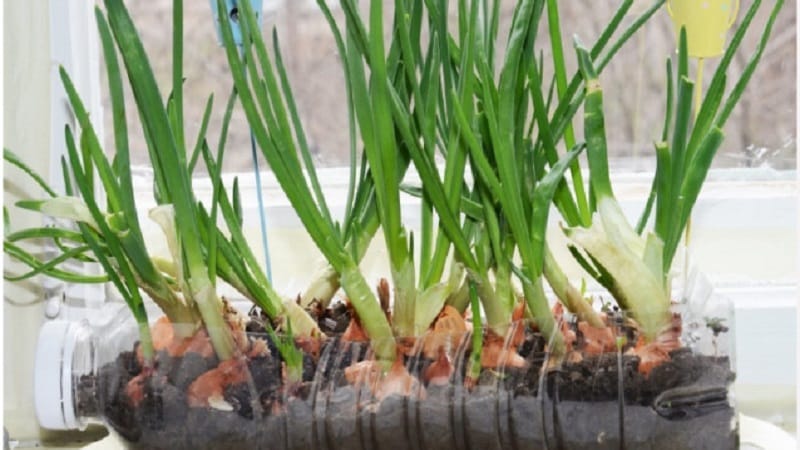
Care
Caring for onions does not involve complex actions.
Basic Rules:
- Lighting. If there is no phytolamp, the plants are turned towards the light twice a day.
- Watering. Onion is a moisture-loving plant. The soil is moistened as it dries. It is important that a dry crust does not appear on it - this will lead to yellowing of the feather.
- Greens absorb any chemicals. Therefore, feeding onions with chemicals is not recommended.
If you follow these simple rules of care, there will be no problems with growing onions.. In disinfected soil, plants do not get sick and are not affected by pests.
Special growing methods
Onions on the windowsill are grown not only in the ground. There are more unusual options.
In water
Growing onions in water is the most popular method. All that is required is to place the onion in a small glass so that its bottom does not touch the water.
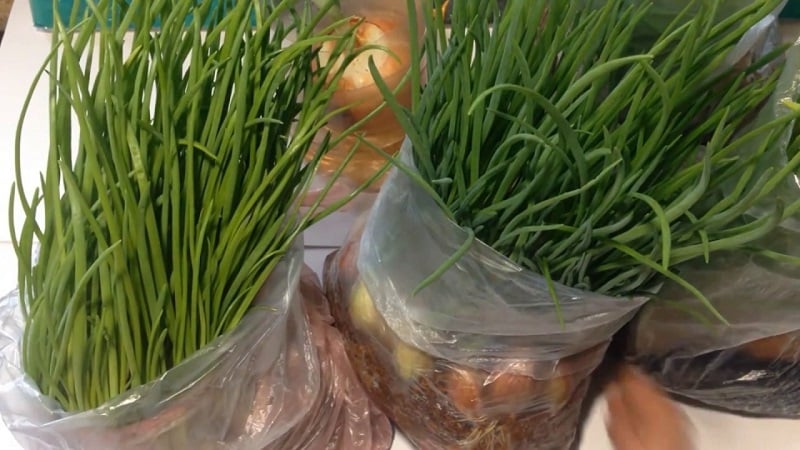
Often the water in the glass acquires an unpleasant odor, becomes slippery, and the onion rots. You have to cut the greens before they reach the optimal size.
To prevent this from happening, it is important to know a few nuances:
- Aeration. To prevent root rotting, there must be air bubbles in the water. This is done in two ways. One option is to plant the onions in a plastic container and run an aquarium compressor there. The second option is to plant onions in egg trays. Pour water into the lower part of the structure. Make holes in the upper cells of such a size that the root bottoms fit there. They should lightly touch the water.There remains free air space, which will provide air exchange.
- Liquid disinfection. To prevent root rot and additionally feed the plants, two tablets of activated carbon are dissolved in water.
On hydroponics
Growing onions hydroponically considered the most modern, simple and expensive way. With its help, you can easily and quickly grow a large amount of greenery, but you will have to buy equipment for planting.

Hydroponics is a setup that includes an aeration system, a nutrient solution and a housing with convenient cells for planting bulbs. All that is required of the gardener is to prepare the planting material in the usual way and plant the bulbs in the cells intended for this. The device is placed in a well-lit, warm place. Then the onion grows almost independently.
Advice. If you allocate an entire room for growing onions and equip it with phytolamps, you will be able to organize a business using a hydroponic installation.
In the sawdust
Growing onions in sawdust is another interesting option for quickly obtaining a rich harvest of greens.
Instructions:
- The sawdust is poured with a boiling light pink solution of potassium permanganate.
- The top part of the onion is cut off by 1-2 cm. This is not done if sprouts have appeared on the planting material.
- The onion is soaked in a solution of potassium permanganate for 30 minutes.
- The bulbs are planted tightly in sawdust so that they spend energy only on forcing the feathers. As the substrate dries, they are watered with warm water. Once a week, the sawdust is moistened with a light pink solution of potassium permanganate.

Harvest and storage
Greens are cut off as soon as the feathers reach a height of 30-50 cm. Store them in the refrigerator. You cannot place onions in a glass of water, as this will cause them to rot.
After trimming the bow will give new arrows. Bulbs that will no longer grow are thrown away.
Tips and tricks
To make growing onions easier and get a rich harvest, use several tricks:
- It is convenient to grow onions in a five-liter bottle. Then you get a lot of greenery from a small area. Holes are made across the entire area of the bottle, matching the size of the widest part of the onion. Holes are also made in the bottom, but smaller ones, so that excess water flows out when watering. The bulbs are inserted into the holes so that the part with the “tail” remains outside. All free space is covered with soil. Water the soil through the open neck of the bottle.
- If you trim the feathers immediately after the greenery appears, the harvest will be richer.
- It is better to wrap pots standing near the radiator with foil to prevent them from overheating. This is also done in the hot summer if the windows face south.
- If you plant new bulbs at intervals of one week, the whole family will be provided with onions throughout the winter.
Conclusion
Even a schoolchild can cope with growing green onions on a windowsill. However, in order to get a truly rich and tasty harvest, it is important to know a few nuances of care - provide the plants with light and maintain temperature conditions.